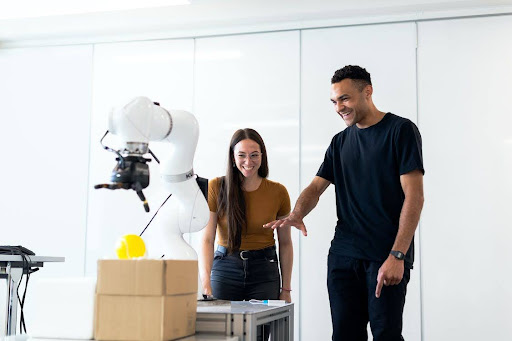
Robotics and engineering have been connected for a long time, but it’s only now that we’re beginning to see the true impact that industrial-scale implementations of this technology can have in this context.
To illustrate the scope of the revolution in engineering that’s being enabled by robots, here is an overview of the main things you need to know.
What Are Industrial Robots?
Industrial robots are autonomous machines capable of performing tasks without human intervention. These versatile tools are widely applied across various industries, including in manufacturing and assembling processes.
The magic of these mechanical maestros lies in their programmability, as you can reassign them to perform different functions according to your engineering needs. This is particularly important in the current climate, where efforts to roll out industrial robots to smaller businesses and even individual hobbyists are ongoing.
In fact we’re seeing industrial robots costs continue to fall as adoption increases, making them viable for more engineering projects by the week. This affordability has opened up countless possibilities in automating complex tasks that were traditionally performed manually.
The Transformative Power Of Robots in Modern Engineering Projects
There are a number of specific areas in which industrial robots have advantages to offer in an engineering context. The headline perks include:
Automation and Efficiency: Robots are excellent for executing repetitive tasks that could be tedious or even hazardous for humans. Through intelligent automation , they significantly boost operational efficiency while also mitigating risks.
High-Quality Output: The meticulous precision associated with robotic systems translates into uniform, high-quality output, which is particularly appreciated in industries like automobile manufacturing where consistent quality is paramount.
Cost Savings: Despite their initial costs, which are coming down as mentioned, industrial robots present long-term financial benefits. They can complete tasks quickly and accurately around the clock, leading to substantial labor-related cost savings over time.
Lastly, industrial robotics tech is not just treading water, but constantly powering ahead to deliver bigger and better opportunities for engineers and organizations. From rapid prototyping to mass production and beyond, the potential is immense.
Opportunities and Challenges Presented By Robotic Automation
As groundbreaking as robotic automation is, it presents a unique blend of opportunities and challenges. First, let’s talk a little more about what they can help to unlock:
Unprecedented Operational Efficiency: The power to complete tasks speedily and efficiently means companies can increase their output capacity without making compromises on quality. This operational efficiency elevates profitability while providing an essential competitive advantage.
Reshaping Workforce Skills: As robots take over manual tasks, employees can focus on higher-value activities that demand creativity or strategic analysis. Of course this shift necessitates reskilling and upskilling , so it is not unambiguously appealing, especially for those in relatively low-skill roles right now.
It’s also necessary to recognize that some challenges loom large in the wake of this revolution:

Initial Investment & Implementation Complexity: Even with costs shrinking, it’s still necessary to splash out to secure the latest industrial robots. Then there are the complexities of the initial implementation stages, which can pose an obstacle to integration.
Dependence on Power Access & Maintenance: Robots require a continuous power supply to remain operational, meaning that unplanned downtime due to factors outside of your control is a likelihood. Meanwhile ensuring their proper functioning requires preventive maintenance routines, which means procurement comes with an ongoing commitment to careful upkeep.
It’s important to get both sides of the story before deciding whether to adopt industrial robots for engineering projects. Making an informed decision is better than jumping on the hype train without proper planning.
Examples of Robotics in Engineering
Industrial robots can already be seen up and running in various places, so here are just a few instances of their successful application to ongoing projects:
Automotive Manufacturing: Car manufacturers routinely deploy robots for arduous tasks like welding, assembly, painting, and even quality control, leading to increased productivity while reducing human injuries.
Construction Industry: Some companies now utilize brick-laying robots to streamline operations, overcoming manpower shortages and also coping with concerns over hazardous working conditions.
Healthcare: Surgical robotic systems allow doctors precise manipulation during complex surgical procedures, enhancing their abilities to operate safely on patients and even automating aspects as well. They sit alongside other technological breakthroughs impacting this sector.
From factories and building sites to hospital rooms and beyond, industrial robots are steadily arriving across various operational avenues. These examples present just a small glimpse into the multifaceted capabilities offered by our autonomous allies.
Future Trends in Robotics
Building on lessons from the past and present, we can anticipate certain key trends that will dictate the future of industrial robots in engineering. These predictions shed light on how technology might continue to shape our world:
Advanced AI Capabilities: With growing artificial intelligence capabilities, robots could take on more complex problem-solving tasks independently, increasing their versatility.
Collaborative Robots: Known as 'cobots', these are designed to physically interact with humans within a shared workspace. Cobots are safer and more flexible than traditional industrial robots, so may soon become more commonplace.
Eco-Friendly Practices: As environmental concerns mount globally, expect future developments in robotics to prioritize sustainability goals. This includes reducing material waste and moving away from carbon-emitting machinery to robots powered by renewable energy.
The road ahead may not always be obvious, but in terms of industrial robots, there is little question that their role in engineering will expand and become more closely intertwined with what experts in the field do from day to day.
The Bottom Line
All of this should paint industrial robots as an unambiguously revolutionary technology, not only for engineering but more generally for business and society at large.
There are those who fear what the robotization of manual tasks might mean for humans, but it seems more likely that this will improve things for workers across the skills spectrum. Whether we’re talking about taking tedious tasks off the table altogether or dramatically enhancing workplace safety, this is a change that should be celebrated rather than treated with suspicion.



